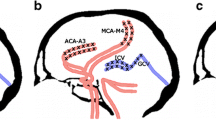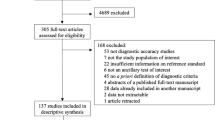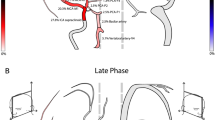Abstract
Background
Physiological instability and confounding factors may interfere with the clinical diagnosis of brain death. Computed tomography angiography (CTA) has been suggested as a potential ancillary test for confirmation of brain death, but its diagnostic accuracy remains unclear.
Methods
We searched MEDLINE, EMBASE, and CENTRAL for studies comparing CTA with other accepted methods of diagnosing brain death (clinical or radiographic). Summary estimates of diagnostic accuracy were computed using random effects models. Subgroup analyses and meta-regression were performed to assess associations between CTA sensitivity and study or patient characteristics.
Results
Twelve studies, involving 541 patients, were included. If the CTA criterion for brain death was complete lack of opacification of intracranial vessels, then the pooled sensitivity was 62 % (50–74 %) for venous phase and 84 % (75–94 %) for arterial phase imaging. The sensitivity of CTA was higher when the criterion for brain death involved absence of opacification of internal cerebral veins, either alone (99 %, 97–100 %) or in combination with lack of flow to the distal middle cerebral artery branches (85 %, 77–93 %). CTA sensitivity was not influenced by different reference standards (clinical vs. radiographic) or predominant diagnostic category (stroke vs. brain trauma). Specificity of CTA could not be adequately determined from the existing data.
Conclusion
Many patients who progress to brain death by accepted clinical or radiographic criteria have persistent opacification of proximal intracranial vessels when CTA is performed. The specificity of CTA in the diagnosis of brain death has not been adequately assessed. Routine use of CTA as an ancillary test in the diagnosis of brain death is therefore not recommended until diagnostic criteria have undergone further refinement and prospective validation. Absence of opacification of the internal cerebral veins appears to be the most promising angiographic criterion.





Similar content being viewed by others
References
Wijdicks EFM, Varelas PN, Gronseth GS, Greer DM. The Quality Standards Subcommittee of the American Academy of Neurology. Evidence-based guideline update: determining brain death in adults. Neurology. 2010;74:1911.
Shemie SD, Doig C, Dickens B, et al. Severe brain injury to neurological determination of death: Canadian forum recommendations. CMAJ. 2006;174:S1–30.
Academy of Medical Royal Colleges. A code of practice for the diagnosis and confirmation of death. London: Academy of Medical Royal Colleges, 2008. Available at: www.aomrc.org.uk/doc_view/42-a-code-of-practice-for-the-diagnosis-and-confirmation-of-death (Accessed March 2014).
Australian and New Zealand Intensive Care Society (ANZICS): The ANZICS statement on death and organ donation (3rd Ed). Melbourne: ANZICS, 2013. Available at: http://www.anzics.comau/death-and-organ-donation (Accessed March 2014).
Busl KM, Greer DM. Pitfalls in the diagnosis of brain death. Neurocrit Care. 2009;11:276–87.
Saposnik G, Basile VS, Young GB. Movements in brain death: a systematic review. Can J Neurol Sci. 2009;36:154–60.
Wijdicks EFM, Rabinstein AA, Manno EM, Atkinson JD. Pronouncing brain death: contemporary practice and safety of the apnea test. Neurology. 2008;71:1240–4.
Savard M, Turgeon AF, Gariepy JL, et al. Selective 4 vessel angiography in brain death: a retrospective study. Can J Neurol Sci. 2010;37:492–7.
Wijdicks EFM. The case against confirmatory tests for determining brain death in adults. Neurology. 2010;75:77–83.
Wijdicks EFM. Brain death worldwide: accepted fact but no global consensus in diagnostic criteria. Neurology. 2002;58:20–5.
Heran MKS, Heran NS, Shemie SD. A review of ancillary tests in evaluating brain death. Can J Neurol Sci. 2008;35:409–19.
Shemie SD, Lee D, Sharpe M, et al. Brain blood flow in the neurological determination of death: Canadian expert report. Can J Neurol Sci. 2008;35:140–5.
Swiss Academy of Medical Sciences. The determination of death in the context of organ transplantation: Medical-ethical guidelines. Available at www.samw.ch. Accessed 28 Mar 2014.
Leclere X, Boulin A, Bracard S, et al. CT angiography for the diagnosis of brain death: recommendations of the French Society of Neuroradiology (SFNR). J Neuroradiol. 2007;34:217–9.
Stroup DF, Berlin JA, Morton SC, et al. Meta-analysis of observational studies in epidemiology: a proposal for reporting. Meta-analysis of Observational Studies in Epidemiology (MOOSE) group. JAMA. 2000;283:2008–12.
Leeflang MMG, Deeks JJ, Gatsonis C, Bossuyt PMM. Systematic reviews of diagnostic test accuracy. Ann Intern Med. 2008;149:889–97.
Landis JR, Koch GG. The measurement of observer agreement for categorical data. Biometrics. 1977;33:159–74.
Berlin JA. Does blinding of readers affect the results of meta-analyses? Lancet. 1997;350:185–6.
Whiting PF, Rutjes AWS, Westwood ME, et al. QUADAS-2: a revised tool for the quality assessment of diagnostic accuracy studies. Ann Intern Med. 2011;155:529–36.
Dupas B, Gayet-Delacroix M, Villers D, et al. Diagnosis of brain death using two-phase spiral CT. Am J Neuroradiol. 1998;19:641–7.
Frampas E, Videcoq M, de Kerviler E, et al. CT angiography for brain death diagnosis. Am J Neuroradiol. 2009;30:1566–70.
Clopper CJ, Pearson ES. The use of confidence or fiducial limits illustrated in the case of the binomial. Biometrika. 1934;26:404–13.
DerSimonian R, Laird N. Meta-analysis in clinical trials. Control Clin Trials. 1986;7:177–88.
Lipsey MW, Wilson DB. Practical meta-analysis. London: SAGE Publications, Inc; 2000.
Lamb T, Arumaithurai K, Shastri R, Putta S. The case for brain death determination by CTA: where are the results. J Trauma Acute Care Surg. 2012;72:1123.
Angstwurm H. CT angiography in the diagnosis of brain death. Dtsch Arztebl Int. 2012;109:623.
Welschehold S, Boor S, Reuland K, et al. CT angiography as a confirmatory test in brain death. Acta Neurochir Suppl. 2012;114:311–6.
Welschehold S, Boor S, Reuland K, et al. Technical aids in the diagnosis of brain death: a comparison of SEP, AEP, EEG, TCD and CT angiography. Dtsch Arztebl Int. 2012;109:624.
Welschehold S, Kerz T, Boor S, et al. Detection of intracranial circulatory arrest in brain death using cranial CT angiography. Eur J Neurol. 2013;20:173–9.
Welschehold S, Kerz T, Boor S, et al. Computed tomographic angiography as a useful adjunct in the diagnosis of brain death. J Trauma Acute Care Surg. 2013;74:1279–85.
Sawicki M, Bohatyrewicz R, Safranow K, et al. Dynamic evaluation of stasis filling phenomenon with computed tomography in diagnosis of brain death. Neuroradiology. 2013;55:1061–9.
Bohatyrewicz R, Sawicki M, Walecka A, et al. Computed tomographic angiography and perfusion in the diagnosis of brain death. Transpl Proc. 2010;42:3941–6.
Orban JC, El-Mahjoub A, Rami L, et al. Transcranial Doppler shortens the time between clinical brain death and angiographic confirmation: a randomized trial. Transplantation. 2012;94:585–8.
Lovrencic-Huzjan A, Vukovic V, Gopcevic A, et al. Usefulness of transcranial Doppler in brain death confirmation. Acta Med Croatica. 2009;63:55–60.
Quesnel C, Fulgencio JP, Adrie C, et al. Limitations of computed tomographic angiography in the diagnosis of brain death. Intensive Care Med. 2007;33:2129–35.
Combes JC, Chomel A, Ricolfi F, et al. Reliability of computed tomographic angiography in the diagnosis of brain death. Transpl Proc. 2007;39:16–20.
Escudero D, Otero J, Marques L, et al. Diagnosing brain death by CT perfusion and multislice CT angiography. Neurocrit Care. 2009;11:261–71.
Berenguer C, Davis FE, Howington JU. Brain death confirmation: comparison of computed tomographic angiography with nuclear medicine perfusion scan. J Trauma. 2010;68:553–9.
Musacchio M, Meyer A, Manoila I, et al. CT angiography in brain death diagnosis: clinical experience in 184 patients. Neuroradiology. 2010;29:46–7.
Rieke A, Regli B, Mattle HP, et al. Computed tomography angiography (CTA) to prove circulatory arrest for the diagnosis of brain death in the context of organ transplantation. Swiss Med Wkly. 2011;141:w13261.
Shankar JJ, Vandorpe R. CT perfusion for confirmation brain death. Am J Neuroradiol. 2013;34:1175–9.
Leclerc X, Taschner CA, Vidal A, et al. The role of spiral CT for the assessment of the intracranial circulation in suspected brain-death. J Neuroradiol. 2006;33:90–5.
Strozyk D, Schwamm LH. False positive CT angiography in brain death. Neurocrit Care. 2009;11(2):272–5.
Braun M, Ducrocq X, Huot JC, et al. Intravenous angiography in brain death: report of 140 patients. Neuroradiology. 1997;39:400–5.
Munari M, Zucchetta P, Carollo C, et al. Confirmatory tests in the diagnosis of brain death: comparison between SPECT and contrast angiography. Crit Care Med. 2005;33:2068–73.
Taylor T, Dineen RA, Gardiner DC, et al. Computed tomography (CT) angiography for confirmation of the clinical diagnosis of brain death. Cochrane Database Syst Rev. 2014;3:CD009694.
Monteiro LM, Bollen CW, van Huffelen AC, et al. Transcranial Doppler ultrasonography to confirm brain death: a meta-analysis. Intensive Care Med. 2006;32:1937–44.
Report of the adhoc committee of the. Harvard medical school to examine the definition of brain death: a definition of irreversible coma. JAMA. 1968;205:337–40.
Wijdicks EF, Pfeifer EA. Neuropathology of brain death in the modern transplant era. Neurology. 2008;70:1234–7.
Young GB, Lee D. A critique of ancillary tests for brain death. Neurocrit Care. 2004;1:499–508.
Joffe AR, Lequier L, Cave D. Specificity of radionuclide brain blood flow testing in brain death: case report and review. J Intensive Care Med. 2010;25:53–64.
Acknowledgments
The authors thank Dr. Peter Faris (PhD, University of Calgary) who provided helpful comments regarding the statistical analysis.
Author information
Authors and Affiliations
Corresponding author
Electronic supplementary material
Below is the link to the electronic supplementary material.
Online Appendix 2
Funnel plot showing relationship between the sensitivity of individual studies (x-axis) and the standard error of the sensitivity (y-axis). (PDF 16 kb)
Rights and permissions
About this article
Cite this article
Kramer, A.H., Roberts, D.J. Computed Tomography Angiography in the Diagnosis Of Brain Death: A Systematic Review and Meta-Analysis. Neurocrit Care 21, 539–550 (2014). https://doi.org/10.1007/s12028-014-9997-4
Published:
Issue Date:
DOI: https://doi.org/10.1007/s12028-014-9997-4




